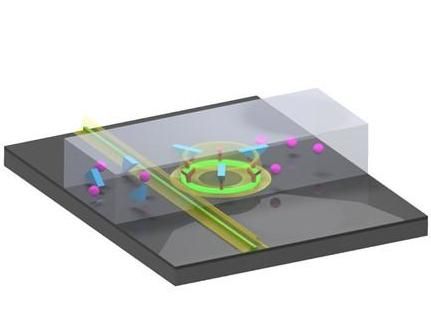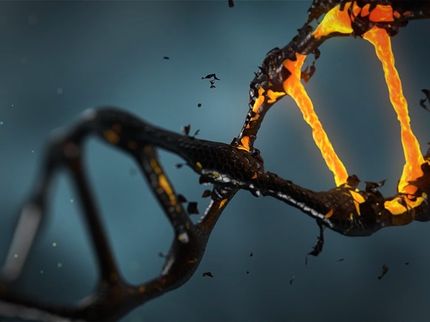Chip-based optical sensor detects cancer biomarker in urine
New technology lays groundwork for biosensors that improve disease diagnosis and monitoring
For the first time, researchers have used a chip-based sensor with an integrated laser to detect very low levels of a cancer protein biomarker in a urine sample. The new technology is more sensitive than other designs and could lead to non-invasive and inexpensive ways to detect molecules that indicate the presence or progression of a disease.

Pump light coupled to the device produced lasing in a microring resonator. The surface of the resonator holds probes (red anchor molecules on the ring) that capture the analytes of interest. The laser light in the ring extends into the fluid. When analytes of interest (blue triangles) attach to the capture probes, this is sensed by the field outside the microring laser, shifting the frequency of the laser emission. This shift can be very precisely measured permitting the detection of minute amounts of analytes flowing over the sensor in a "specific" manner (i.e., the pink particles do not bind to the capture layer and are therefore not detected). In the figure, the waveguide are green (real color produced by upconversion of the dopants that induce the laser emission) and a microfluidic channel can be seen in which different particles flow from left to right.
Rick Seubers, Optical Sciences group, University of Twente
"Current methods to measure biomarker levels are expensive and sophisticated, requiring biopsies and analysis in specialized laboratories," said research team leader Sonia M. Garcia-Blanco from the University of Twente in the Netherlands. "The new technology we developed paves the way to faster and ultra-sensitive detection of panels of biomarkers that will permit doctors to make timely decisions that improve personalized diagnosis and treatment of medical conditions including cancer."
In The Optical Society (OSA) journal Optics Letters, a multi-institutional group of researchers funded by the H2020 European project GLAM (Glass multiplexed biosensor), shows that the new sensor can perform label-free detection of S100A4, a protein associated with human tumor development, at levels that are clinically relevant.
"The biosensor could enable point-of-care devices that simultaneously screen for various diseases," said Garcia-Blanco. "Its operation is simple and does not require complicated sample treatments or sensor operation, making it an excellent candidate for clinical applications."
The researchers say that the sensor holds potential for non-biomedical applications, as well. For example, it can also be used to detect different types of gases or liquid mixtures.
Creating a high-sensitivity sensor
The new chip-based sensor detects the presence of specific molecules by illuminating the sample with light from an on-chip microdisk laser. When the light interacts with the biomarker of interest the color, or frequency, of this laser light shifts in a detectable way.
To perform detection in urine samples, the researchers had to figure out how to integrate a laser that could operate in a liquid environment. They turned to the photonic material aluminum oxide, because when doped with ytterbium ions it can be used to fabricate a laser that emits in a wavelength range outside the light absorption band of water while still enabling the precise detection of the biomarkers.
"Although sensors based on monitoring frequency shifts of lasers already exist, they often come in geometries that are not easily integrated on small, disposable photonic chips," said Garcia-Blanco. "Aluminum oxide can easily be fabricated monolithically on-chip and is compatible with standard electronic fabrication procedures. This means that the sensors can be produced on a large, industrial scale."
Using a microdisk laser rather than the non-lasing ring resonators used in other similar sensors opens the door to unprecedented sensitivity. The sensitivity comes from the fact that the lasing linewidth is much narrower than the resonances of passive ring resonators. Once other noise sources, such as thermal noise, are eliminated, this method will allow the detection of very small frequency shifts from biomarkers at very low concentrations.
Detecting minute biomarker concentrations
After developing and applying a surface treatment that captures the biomarkers of interest in complex liquids such as urine, the researchers tested the new sensor with synthetic urine containing known biomarker levels. They were able to detect S100A4 at concentrations as low as 300 picomolar.
"Detection in this concentration range shows the potential of the platform for label-free biosensing," said Garcia-Blanco. "Furthermore, the detection module can be potentially made very simple using the developed technology, bringing it a step closer to the final application outside of the laboratory."
The researchers are working to incorporate all the relevant optical sources and signal generation components onto the chip to make the device even simpler to operate. They also want to develop various coatings that could allow parallel detection of a large variety of biomarkers.


























































